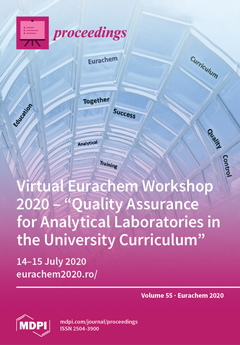Need Help?
Proceedings, 2020, Eurachem 2020
The Virtual Eurachem Workshop 2020—“Quality Assurance for Analytical Laboratories in the University Curriculum”
online | 14–15 July 2020
Volume Editors:
Eugenia Eftimie Totu, University Politehnica of Bucharest, Romania
Ana Maria Joşceanu, University Politehnica of Bucharest, Romania
- Issues are regarded as officially published after their release is announced to the table of contents alert mailing list.
- You may sign up for e-mail alerts to receive table of contents of newly released issues.
- PDF is the official format for papers published in both, html and pdf forms. To view the papers in pdf format, click on the "PDF Full-text" link, and use the free Adobe Reader to open them.
Cover Story (view full-size image):
The Eurachem Workshop, usually organized in connection with the Eurachem General Assembly, annually gathers a broad audience of specialists for quality assurance in chemistry, accreditation,
[...] Read more.
The Eurachem Workshop, usually organized in connection with the Eurachem General Assembly, annually gathers a broad audience of specialists for quality assurance in chemistry, accreditation, metrology, education and training, as well as scientists and highly skilled professionals, focusing on promoting quality and excellence in analytical chemistry across Europe. The year 2020 is a peculiar year, imposing specific actions in all our activities following the ongoing pandemic. Consequently, the first virtual Eurachem Workshop hosted by University Politehnica of Bucharest, Romania, took place on 14–15 July 2020. Participants from 23 countries attended the Eurachem event. The present issue of Proceedings represents a partial collection of the abstracts presented during the virtual workshop: “Quality assurance for analytical laboratories in the University curriculum”.
Previous Issue
Next Issue
Issue View Metrics
Multiple requests from the same IP address are counted as one view.



